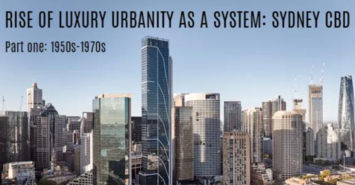
In 1971, after a lifetime researching and explaining the Central Business District, American geographer Raymond Murphy gathered his knowledge together in The Central Business District: A Study in Urban Geography. Murphy defined the CBD as a region “draw[ing] its business from the whole urban area and from all ... classes of people.” But that definition would soon be redundant.
Since at least the 1980s, central areas of many world cities like Sydney have evolved from classic industrial era CBDs into more exclusive socio- economic phenomena. The mid-twentieth century brought tensions between a growing suburban periphery driven by mass motorisation and a stagnating, post-industrial inner-city. After an interval at the crossroads, urban centres were refitted as global high-amenity enclaves. These former industrial-mercantile junctions, which distributed goods across whole regions, now radiate little more than inflated land and property prices. Some call this a “shift from the city as a site of production to one of consumption.” Disruptive events like financial crises and the recent Covid- 19 pandemic shaped the course of this evolution.
Sydney’s classic CBD morphology peaked in the 1970s and has been fading ever since. Occasionally, the emerging phenomenon rates a mention in academic literature and popular journalism, but there is still no consensus about its character or economic logic. Many seem reluctant to concede its discontinuity from the classic CBD, fearing to unmask a new stage in the concentration of privilege.
Politicians, property developers and academics tend to downplay the CBD’s loss of functional centrality in Greater Sydney. Since the 1950s, the legacy CBD’s relative share of metropolitan jobs has plummeted from almost a half to around a tenth, and in today’s post-material conditions owes more to a disproportionate allocation of amenities than any unique productivity advantage. The pandemic forced some recognition of reality but notions of natural centrality persist. “The CBD is Dead, Long Live the Central Social District” proclaimed an article by former NSW Cities Minister Rob Stokes. Suggestions that CBD-centric planning is bad for housing affordability, commuting or small business formation are generally disputed.
For a better perspective it is useful to contrast features of today’s ‘post- CBD’ with elements of the classic CBD structure as identified by urban geographers in the literature.
While the spatial order of the old industrial-mercantile CBD was arranged around functions, the contemporary ‘centre’ is laid out for amenities. This new urban logic, called ‘luxurification’ by some scholars, takes form as an upward spiral of amenity enhancements, feeding off soaring peaks in the land value cycle, gentrification on a global scale and ‘sustainable urbanism.’ On very high-priced sites developers will typically maximise returns by substituting capital for land, building larger and taller structures. Scaling up amenities in the structures and on the surrounding ground plane can augment capital. Thus luxurification is sweeping through most features of the CBD landscape, reaching office, retail, leisure-hospitality and residential building stock as well as the streetscapes, transit facilities and public spaces in between. In the office sector, where the CBD vacancy rate is now at a 30-year high, this is commonly referred to as a “flight to quality”.
Read the rest of this piece at The New City Journal (PDF).
John Muscat is a co-editor of The New City Journal. The article above is excerpted from the introduction to his report.












